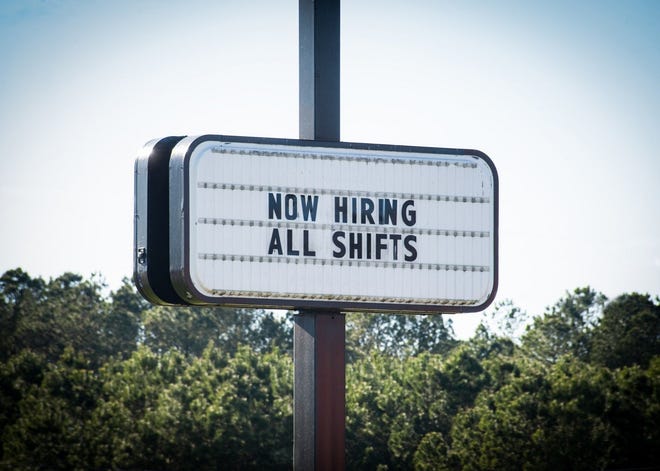
Hiring slowed sharply for a second straight month in December, with employers adding just 199,000 jobs, as the omicron variant began driving COVID-19 cases higher.
The unemployment rate fell to 3.9% from 4.2% the prior month, the Labor Department said Friday.
Economists surveyed by Bloomberg had estimated that 444,000 jobs were added last month.
A modest consolation: Job gains for October and November were revised up by a total 141,000, though November's sluggish 210,000 was nudged up by just 39,000.
For all of 2021, the economy added a record 6.4 million jobs, or 537,000 a month, as the nation continued to recover from the unprecedented losses caused by a pandemic-induced recession and shutdowns of 2020. So far, the U.S. has recouped 18.8 million, or 84%, of the 22.4 million jobs lost early in the pandemic, leaving it 3.6 million jobs shy of its pre-crisis level.
The omicron surge could delay that recovery in the short term. The strain propelled daily COVID cases above 1 million this week, shattering previous records, but most analysts reckoned it occurred too late in the month to dampen the government’s December survey, which is conducted the week that includes the 12th.
Meanwhile, job growth had appeared set for a healthy rebound from disappointing November gains as widespread worker shortages eased slightly. The expiration of enhanced unemployment insurance in early September failed to immediately lift employment gains, but Goldman Sachs expected a bounce last month as many of the 4.6 million workers who lost benefits resumed their job searches.
Also, employers are hesitant to let workers go because of the labor shortages. Initial jobless claims, a gauge of layoffs, have tumbled even below their pre-COVID mark in recent weeks.

And unseasonably warm weather in early December should have juiced job increases in industries such as construction, Goldman estimated.
Construction did add a solid 22,000 jobs but other industries turned in tepid showings, according to Labor's survey of businesses. Leisure and hospitality, which includes restaurants and bars and was hit hardest by the pandemic, led the job gains with 53,000 but that's well below it's average advances in the recovery. The sector is still down 1.2 million jobs compared to its pre-pandemic level. Professional and business services added 43,000; manufacturing, 26,000; construction, 22,000; and transportation and warehousing, 19,000.
Retail lost 2,100 jobs and federal, state and local governments shed 12,000.
Yet for a second month, a separate survey of households was significantly more encouraging, revealing substantial job gains that drove the unemployment rate lower and leaving economists to debate which poll better reflects the state of the labor market. The survey of business establishments is more extensive and generally deemed more accurate.
The December report may have captured employers' uncertainty about hiring as omicron took hold. The variant is expected to significantly slow job gains early in the year as workers again pause job hunts and shoppers curtail spending on dining out and other activities, says economist Lydia Boussour of Oxford Economics.
“As we enter 2022, near-term labor market prospects are dimming amid a tidal wave of Omicron cases,” Boussour writes in a note to clients.
Vaccination mandates by private employers as well as coming or recent government vaccination mandates for certain groups of workers also may have dampened job growth last month as some workers who refuse to get vaccinated quit, Goldman said.
Homebase, which supplies payroll software to small businesses, said the number of employees working and the number of hours worked declined last month.
The good news is the variant appears far less severe than the previous delta strain and is likely to peak in the next few weeks and peter out by March, health experts say. That should set the stage for slower but still booming employment gains of about 330,000 a month this year, according to Moody’s.
Megan Shroy, CEO of Columbus-Ohio-based Approach Marketing, expanded her staff of full-time workers and contractors by about 40% last year and expects to grow it by another 20% in 2022 amid surging demand. Clients, she says, are still making up for cutbacks in their public relations and digital marketing outlays in 2020, when the health crisis upended the economy.
Shroy says she hasn’t been affected by the labor shortage because all her employees work remotely and she allows them to toil flexible hours and part-time if they need to, catering to a new COVID-spawned mindset that balances work and personal life.
“We’re getting a lot of candidates (from companies that are requiring employees to return to the office) who are saying, ‘This what I prefer.”
Source link






